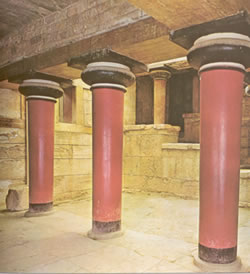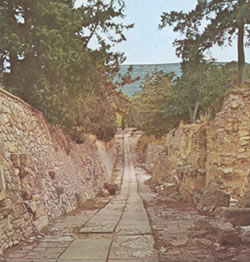 Crete was a major trade center during Minoan times. The Minoan culture that developed there was known for its luxurious way of life. Evans' first digs in
Knossos in 1900 revealed remains of walls close to the surface, and in a few weeks, remains of buildings were exposed, covering and area of 8,480 square feet. The palace
remains sprawled over five and a half acres.
Crete was a major trade center during Minoan times. The Minoan culture that developed there was known for its luxurious way of life. Evans' first digs in
Knossos in 1900 revealed remains of walls close to the surface, and in a few weeks, remains of buildings were exposed, covering and area of 8,480 square feet. The palace
remains sprawled over five and a half acres.
The first palace was dated at around 2000 B.C. It was completely destroyed by an earthquake three centuries later. The new (second) palace, labyrinthine in design, followed immediately. In the middle of the 15th century B.C. the Achaeans from mainland Greece conquered the island and settled at the palace of Knossos. They used the Greek language using the Linear B script as evidenced on clay tablets. The palace was again destroyed by fire in the mid-15th century B.C. and ceased to function as a palatial center.
 There is also controversy surrounding the question of how Knossos was finally destroyed. Though Evans believed that it was due to a massive seismic
occurrence, many experts believe that Crete was invaded and destroyed by either Dorians, Achaeans or Mycenaean's.
There is also controversy surrounding the question of how Knossos was finally destroyed. Though Evans believed that it was due to a massive seismic
occurrence, many experts believe that Crete was invaded and destroyed by either Dorians, Achaeans or Mycenaean's.
Evans found thousands of artifacts and from them assigned various functions to the chambers and from their level of craft recognized a highly developed culture with a great love of beauty.
Even vessels for oil were beautifully ornamented. These were the huge 'pithoi' kept in storerooms and were found to have contained up to 19,000 gallons of oil. There were artifacts of bronze, pottery, stone, terra cotta and artwork that showed bulls dancing, suggesting possible sacrifice of youths to a bull. (left the Grand staircase light well)
 The Minoan's, unlike later temple builders, designed their palaces to face west rather than east. Visitors today
approach the palace via the West Court, which was possibly a marketplace and public meeting place. (the Royal Road right)
The Minoan's, unlike later temple builders, designed their palaces to face west rather than east. Visitors today
approach the palace via the West Court, which was possibly a marketplace and public meeting place. (the Royal Road right)
The Central Courtyard of the palace was found to resemble a labyrinth, with four wings surrounding it. Its paving covers the site's oldest remains, dating back to Neolithic times. Though some of Evans restoration was clearly guesswork, the Royal Apartments (among the most beautiful at Knossos) are not.
The Grand Staircase that leads to them is not only beautiful in design, but its 'well' brings light into the lower stories. Such wells usually have a courtyard at the bottom and are a common feature of Knossos. The chambers are luxurious-the Queen's Suite an example of this, its main room with its copy of the famous dolphin fresco which was actually found in a courtyard and not in this chamber. The original is in the Heraklion Archaeological Museum. The room opens onto courtyards that let in light and air.